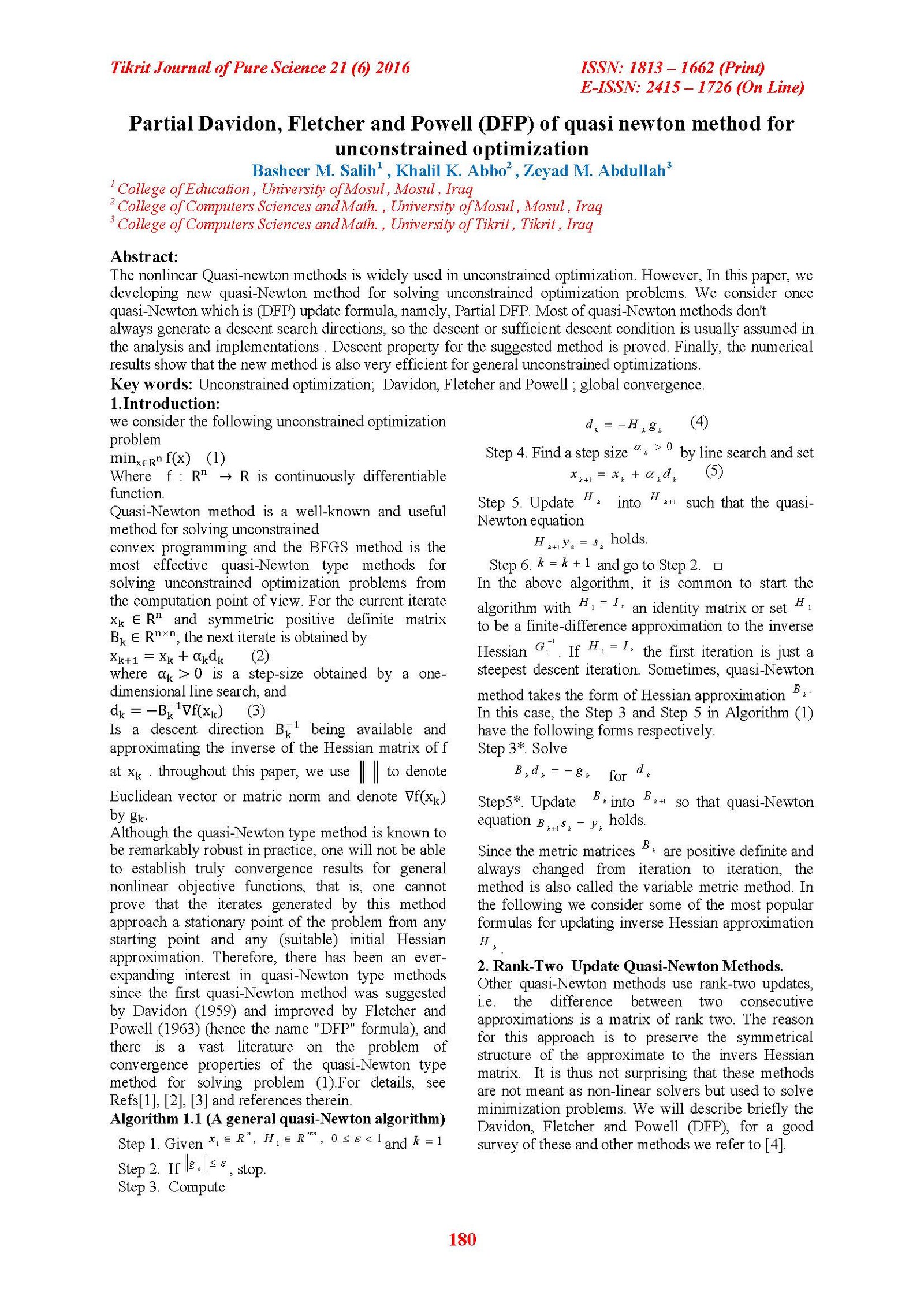Partial Davidon, Fletcher and Powell (DFP) of quasi newton method for unconstrained optimization
Main Article Content
Abstract
The nonlinear Quasi-newton methods is widely used in unconstrained optimization. However, In this paper, we developing new quasi-Newton method for solving unconstrained optimization problems. We consider once quasi-Newton which is (DFP) update formula, namely, Partial DFP. Most of quasi-Newton methods don't
always generate a descent search directions, so the descent or sufficient descent condition is usually assumed in the analysis and implementations . Descent property for the suggested method is proved. Finally, the numerical results show that the new method is also very efficient for general unconstrained optimizations.
Article Details

This work is licensed under a Creative Commons Attribution 4.0 International License.
Tikrit Journal of Pure Science is licensed under the Creative Commons Attribution 4.0 International License, which allows users to copy, create extracts, abstracts, and new works from the article, alter and revise the article, and make commercial use of the article (including reuse and/or resale of the article by commercial entities), provided the user gives appropriate credit (with a link to the formal publication through the relevant DOI), provides a link to the license, indicates if changes were made, and the licensor is not represented as endorsing the use made of the work. The authors hold the copyright for their published work on the Tikrit J. Pure Sci. website, while Tikrit J. Pure Sci. is responsible for appreciate citation of their work, which is released under CC-BY-4.0, enabling the unrestricted use, distribution, and reproduction of an article in any medium, provided that the original work is properly cited.
References
[1] Al-Baali, M. (1985). Descent property and global convergence of the Fletcher-Reeves method with inexact line search, IMA J. Num. Anal., 5, 121-124.
[2] W.C. Davidon, Variable-metric Method for Minimization, AEC Report ANL5990, Argonne National Laboratory, 1959.
[3] Pearson D.(1969):'Variable Metric methods for minimization'. Computer Journal vol.12.
[4] J.Z. Zhang, C.X. Xu, Properties and numerical performance of quasi-Newton methods with modified quasi-Newton equations, J. Comput. Appl. Math. 137 (2001) 269–278.
[5] Davidon, W. C. (1959). Variable metric method for minimization, AEC Res. and Report ANL-5990 (revised).
[6] Fletcher, R. and Powell, M. J. D. (1963). A rapidly convergent descent method for minimization, Computer. J., 6, 163-168.
[7] Powell, M. J. D. and Yuan, Y. (1986). A recursive quadratic programming algorithm that uses differentiable penalty functions, Math. Prog., 35, 265-278.
[8] Sugiki K. Narushima Y. and Yube H. (2012)' Globally convergence three- term conjugate gradient methods that uses secant conditions and generate descent search direction, for unconstrained optimization. J. of optimization theory and Applications 153.
[9] Bongartz, I., A.R. Conn, N.I.M. Gould and Ph. L. Toint, 1995. CUTE: Constrained and unconstrained testing environment: ACM Trans. Math. Software, 21: 123-160. http://portal.acm.org/citation.cfm?doid=200979.201043.
[10] Andrei, N., Scaled conjugate gradient algorithms for unconstrained optimization. Computational Optimization and Applications 38, 401-416 (2007).
[11] Andrei, N., A hybrid conjugate gradient algorithm with modified secant condition for unconstrained optimization. ICI Technical Report, February 6, 2008.
[12] Dolan, E.D. and J.J. Moré, 2002. Benchmarking optimization software with performance profiles. Math. Program., 91: 201-203, DOI: 10.1007/ s101070100263.
